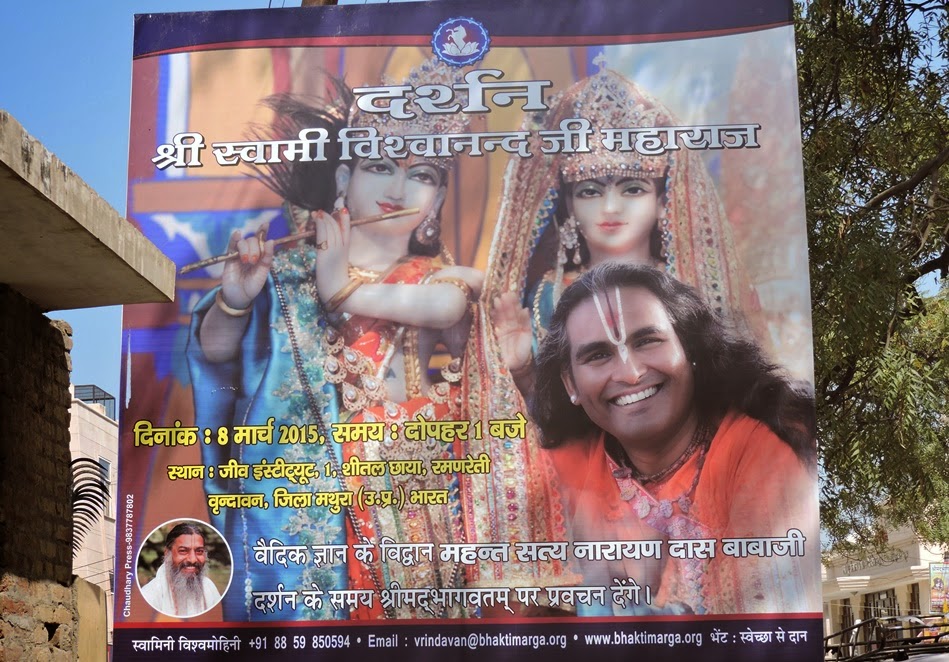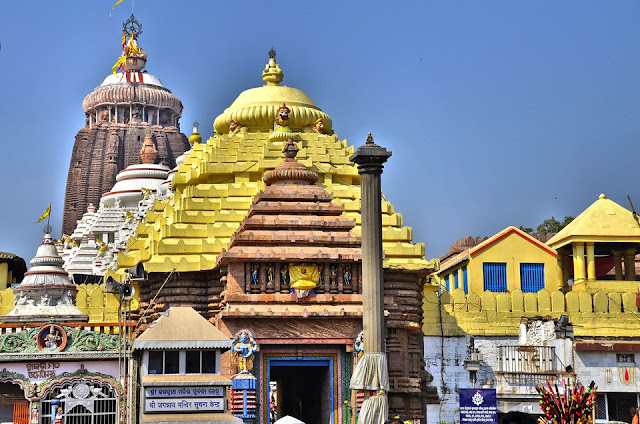Gopala-vijaya IV: Barai Buri
We have had some occasion to discuss the Barai Buri in an earlier post (The Play in Chandrasekhara's House). She makes her appearance, on cue, in chapter 30 of GPVJ, after Radha and her friends have been getting dressed.
It is also worthy of note here that Radha is surrounded by friends in a way that she is not in Gita Govinda (where there are competitors and only one faceless friend acts as go-between) or SKK (where the sakhis are insignificant). A sakhi named Chandramukhi plays a role in the next chapter also.
In chapter 30, after Radha and her sakhis have dressed themselves and look like "the dancing girls of heaven" (svargera nācanī), they are joined by Barai Buri. She is described in the classical way that the procuress or bawd is in much earlier works like Kuṭṭanī-mata. Some of the items I liked: Her teeth are like a row of garlic buds (rasunera gajā jena daśana-śikhare)! Her eyes are like those of an owl in a hollow tree. She is, of course, bent over completely. She appears to be still married, as she has the red mark in her hair part, though her hair is completely white. The description concludes with the following verse:
heno rūpa āgu jāi prāṇera baḍāi jeno mūrtimāna hāsya bhūmite beḍāi
This is pretty instructive. As an ancient tradition in India (as I already said, the old woman, in particular the dissolute aged prostitute in Kuṭṭanī-mata and other works of the genre) is an object of laughter. I remember quite clearly one boy about ten years old we had in the Mayapur Gurukula would bend over like a hunchback, as a Buri. In fact, it is not rare to see older Bengali women who at some point are no longer able to straighten up, as they have spent so much of their life crouching, bending over to do household tasks.
We don't get her as a relative to Krishna here, as in SKK where she is related to both, and as such makes a good go-between. At the same time, Devakinandan's Barai is nothing like the vindictive old hag in SKK. Chandidas's Krishna asks Barai to act as a go-between, but not nearly as respectfully as Devakinandan's. Krishna says,
śiśu-kāla hoite baḍāi jāni saba ṭhāi prāṇake adhika more bāsaha baḍāi saba goālāra tuhmi kulera gosāñī tohmāra āśiṣe kabhu mana duskha nāi
As in SKK, he claims not to know who she is. I speculate that perhaps the incident earlier where Ma Yashoda gets angry with Radha (see previous post, introduction to GPVJ) lead to a long period of not seeing each other. This would be the way to make the two versions coincide. Anyway, after this admission, Krishna takes shelter of Badai,
nānā bhae saba tribhuvana āhmi tāri se āhmi śaraṇa tome rākhaha murāri
buḍhira bharchhane se bharchhana nāhi māne kāmātura lāja nāñi saba loka jāne
śiśu-kāla hoite baḍāi jāni saba ṭhāi prāṇake adhika more bāsaha baḍāi saba goālāra tuhmi kulera gosāñī tohmāra āśiṣe kabhu mana duskha nāi
hera kahi dāmodara āhmā nā bāsiha para āhmi tora marame bhitare tora guṇe siddha kāje āmi upalakṣya mājhe ārati nā koriha antare
kṣidāe adanta vatsa jena cāhe māe hena mate kāhnāi baḍāi pāne cāe
Barai's status is much greater in GPVJ compared to SKK, where she is given a more "human" touch. In GPVJ, in order to reestablish the gopis' trips to Mathura, and thereby arrange the possibility of the Dana-lila, Barai goes to Nanda Maharaj and has him organize a meeting with all the men to promote the idea. At this assembly, where Aihana is an important participant, she is the principal speaker.
Basing her knowledge on information received from Akrura, she says that she has heard various criticisms of the cowherds from Mathura. Kamsa is saying that Nanda Maharaj and the cowherds have become puffed up and think that their womenfolk should be kept in seclusion like queens and so have forbidden them from going to the Mathura market to sell their goods. The gopis themselves look down their noses at the dairy products. Nanda thinks he has become a king. Because of this, Kamsa has not been getting the requisite taxes. Akrura advised that Krishna and Balaram should go into the forest separately [to avoid the dangers of assassination] and the gopis should start going to Mathura with dairy goods.
Everyone agrees and the stage is set for Dana-lila.
My point in relation to Barai is that she expands into the whole lila, and all the lila parikaras in Rupa Goswami. In the first instance we have Radha + Krishna, then Yogamaya, then the sakhi, and then all the sakhis, sakhas and manjaris. More will no doubt follow.
It is also worthy of note here that Radha is surrounded by friends in a way that she is not in Gita Govinda (where there are competitors and only one faceless friend acts as go-between) or SKK (where the sakhis are insignificant). A sakhi named Chandramukhi plays a role in the next chapter also.
In chapter 30, after Radha and her sakhis have dressed themselves and look like "the dancing girls of heaven" (svargera nācanī), they are joined by Barai Buri. She is described in the classical way that the procuress or bawd is in much earlier works like Kuṭṭanī-mata. Some of the items I liked: Her teeth are like a row of garlic buds (rasunera gajā jena daśana-śikhare)! Her eyes are like those of an owl in a hollow tree. She is, of course, bent over completely. She appears to be still married, as she has the red mark in her hair part, though her hair is completely white. The description concludes with the following verse:
The beloved old lady walked ahead [of the gopis] looking like, this--the personification of laughter walking on the Earth.Now the intention of mūrtimān hāsya might be better expressed as "the incarnation of the comic rasa."
This is pretty instructive. As an ancient tradition in India (as I already said, the old woman, in particular the dissolute aged prostitute in Kuṭṭanī-mata and other works of the genre) is an object of laughter. I remember quite clearly one boy about ten years old we had in the Mayapur Gurukula would bend over like a hunchback, as a Buri. In fact, it is not rare to see older Bengali women who at some point are no longer able to straighten up, as they have spent so much of their life crouching, bending over to do household tasks.
We don't get her as a relative to Krishna here, as in SKK where she is related to both, and as such makes a good go-between. At the same time, Devakinandan's Barai is nothing like the vindictive old hag in SKK. Chandidas's Krishna asks Barai to act as a go-between, but not nearly as respectfully as Devakinandan's. Krishna says,
"I have known you since the time of my childhood [an alternate reading says: "you have fulfilled my desires since my childhood"], so you are more to me than life itself. You are the spiritual master [Gosani] of all the cowherd community and anyone who gets your blessings never needs suffer." (31.68-69)And a bit later, after describing briefly his own glories and accomplishments, he admits that despite it all he has been affected by Radharani's glances and has lost his composure.
As in SKK, he claims not to know who she is. I speculate that perhaps the incident earlier where Ma Yashoda gets angry with Radha (see previous post, introduction to GPVJ) lead to a long period of not seeing each other. This would be the way to make the two versions coincide. Anyway, after this admission, Krishna takes shelter of Badai,
"I save the world from all manner of fear, but I am taking shelter of you. Please save Murari." (31.89)Barai then chastizes Krishna for wanting to enter into a relationship with a married woman. ("Up until now you got away with it because you were just a little kid. But now if you start to play the rake..."). Again, this is unlike SKK where Barai is actively encouraging Krishna. But, and here Krishna looks a little more like Chandidas's version, Devakinandan says,
Krishna paid no attention to Barai's chastisements. Everyone knows that a person suffering the pangs of lust has no shame. (31.101)In the next chapter, the same theme continues. Krishna says to Barai, I defeated gods like Indra and killed various demons, he says to Barai,
"I have known you since the time of my childhood [an alternate reading says: "you have fulfilled my desires since my childhood"], so you are more to me than life itself. You are the spiritual master [Gosani] of all the cowherd community and anyone who gets your blessings never needs suffer." (32.5)Barai herself says:
Listen to me, Damodar. Don't think of me as someone who is not on your side. I am inside your most intimate desires. But ultimately [and isn't this nice] you will be successful because of your own virtues and I can only act as an external instrument. So don't be worried about what will happen. (32.13)Later again, when Barai has gone to attempt to convince Radha, Krishna awaits her return:
Like a baby who has yet to grow a tooth looks towards his mother, so Kanai looked at Badai. (35.4)Anyway, Barai is definitely recognizable as the hag archetype, which here combines that pitiful state of aged woman, with simultaneous mystic powers (a witch), but tempered here with a kindly wisdom.
Barai's status is much greater in GPVJ compared to SKK, where she is given a more "human" touch. In GPVJ, in order to reestablish the gopis' trips to Mathura, and thereby arrange the possibility of the Dana-lila, Barai goes to Nanda Maharaj and has him organize a meeting with all the men to promote the idea. At this assembly, where Aihana is an important participant, she is the principal speaker.
Basing her knowledge on information received from Akrura, she says that she has heard various criticisms of the cowherds from Mathura. Kamsa is saying that Nanda Maharaj and the cowherds have become puffed up and think that their womenfolk should be kept in seclusion like queens and so have forbidden them from going to the Mathura market to sell their goods. The gopis themselves look down their noses at the dairy products. Nanda thinks he has become a king. Because of this, Kamsa has not been getting the requisite taxes. Akrura advised that Krishna and Balaram should go into the forest separately [to avoid the dangers of assassination] and the gopis should start going to Mathura with dairy goods.
Everyone agrees and the stage is set for Dana-lila.
My point in relation to Barai is that she expands into the whole lila, and all the lila parikaras in Rupa Goswami. In the first instance we have Radha + Krishna, then Yogamaya, then the sakhi, and then all the sakhis, sakhas and manjaris. More will no doubt follow.




Comments
Perhaps not only the hag archetype, but the crone archetype.
By that I mean: when you are young, or inexperienced: the crone looks even scary, pitiable at best and terrifying at worst.
However as one ages or become mature or has spiritual vision, the crone also has strengths:
such as: due to no more estrogen, her mind is not "on drugs".
i.e. recently in a book about Women at Fifty, had an interview in which a famous actress said
no one tells you that when you lose your estrogen you lose your lips; they start thinning. And is very scary experience because no one warns you or tells you. And is taboo to discuss in a Youth Culture Society.
Is more taboo to discuss than the various sexual programmings anyone can see on Tv, cable, internet, magazines 24/7. Must hide it away like the homeless, old age homes, people in jails, etc.
And also another thing the actress mention was when you have no more estrogen then men look like a bad acid trip, when you think about to have sex with them.
And you wonder what kind of drugs you were on that made you want to hug men or even think hairy creatures like that, kind of brutish, were attractive.
Then the actress was put on hormone replacement therapy and the men looked interesting and desirable again.
So the crone archetype is someone who is not under the influence of the hormone estrogen, which in turn affects people's decision-making powers.
Therefore, the crone person has a type of wisdom that the estrogen-crazed person does not have.
There is beauty in life at all of the stages. Hag kind of imply is not beautiful. But crone implies has some type of a wisdom and power.
Basically every female embodied person will go through all of the different archetypes or stages.
Those archetypes all seen in the Braj lilas.
Jaya Sri Radhe!!!
Ha. Ha. Most men look like that anyway, with a few exceptions.
Your theory might hold except for, with the fall in estrogen comes a rise in testosterone (testosterone is a sexual hormone in both men and women). That combined with the fact that post-menopause you do not have to worry about getting pregnant, many women experience a sort of sexual re-awakening in their 50s. In fact, one woman just told me as much the other day - that she reached her sexual peak in her early 50s, precisely because of these reasons. She is currently in her mid 50s and dating a plethora of younger men in their 40s.
But culture-wise, your theory probably holds up in places like India, where dating is taboo and where dating younger men in your post-menopausal years would be unheard of.
Jagat, I love the photo here of this old Indian woman. She looks familiar to me, I'm sure I've seen here roaming around Vrindavan, perhaps doing parikrama of Radha-Damodar.
The old women of India have simultaneously an annoying yet endearing quality about them. Their demeanors often betray a hard life of emotional turmoil and neglect.
When they were married as young bahus they had to become totally subsumed by their saasural. Really, in traditional small town and village India where the extended family lives as joint family under one roof, the youngest and newest bahu is nothing more than a slave to all of them.
Finally, after decades of being bossed around and verbally abused (and in some cases physically), she herself graduates to becoming the MATRIARCH of the household, when her saas passes on and she herself becomes a saas.
Watch out! That's when she unleashes all the repressed angst that has build up inside of her over the years.
And the cycle perpetuates itself as she begins to harrass and enslave her precious beta's new bride.
I'll leave it at that without getting into the psycho-sexual-social dynamics between the Indian mother and her beloved son.
From Wikipedia regarding a retirement community in America by the name of "The Villages"...
In 2006, it was reported by Dr. Colleen McQuade, that The Villages had experienced several outbreaks of some sexually transmitted diseases, normally associated with younger people, amongst seniors. A doctor blamed Viagra, a lack of sex education, and no risk for pregnancy for the spike in sexually transmitted diseases at The Villages.[11]